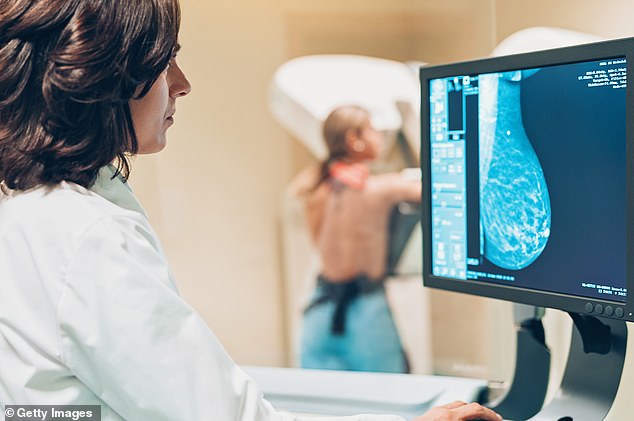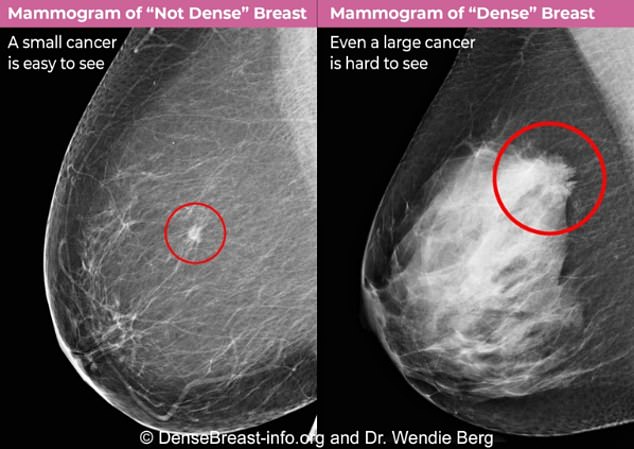All health care providers in the United States will be required to check women’s breast density during routine breast cancer screening exams.
Beginning this week, all mammogram reports and results letters sent to patients in the U.S. will be required to include an assessment of breast density.
Mammograms are the gold standard for breast cancer screening, but the test may miss cancerous lumps if a woman’s breasts are dense, meaning they have a large amount of fibrous tissue relative to the amount of fatty tissue.
About half of women in the U.S. have dense breasts, which means they are at risk of being wrongly told they don’t have cancer, allowing the disease to spread.
If your breasts are found to be composed primarily of dense fibrous tissue, the FDA suggests additional imaging with your doctor.
Fatty tissue, which appears dark on a mammogram, makes it easier to detect tumors because they stand out more compared to dense, fibrous tissue. Image courtesy of Densebreast-info.org
In 38 states and Washington DC alone, doctors were required to inform women of their increased risk of cancer because of this.
Other states had no such requirement, even though dense breast tissue can cause a sixfold increase in cancer risk.
Under the new FDA regulation, all healthcare facilities in the country are required to disclose this “critical” information to patients.
Dense breast tissue appears white on mammographic images created by X-rays, which can mask or hide small cancerous masses that also appear white.
This makes it difficult for doctors to differentiate between normal tissue and cancer.
Fatty tissue, which appears dark on a mammogram, makes it easier to detect tumors because they stand out more.
FDA Chief Medical Officer Dr. Hilary Marston said, “Today’s action represents the agency’s broadest commitment to supporting innovation to prevent, detect and treat cancer.”
The FDA rule, which goes into effect today, updates the Mammography Quality Standards Act of 1992.
This law requires the Department of Health and Human Services (HHS) to develop standards and gives the FDA the power to verify the accreditation and certification of mammography facilities, ensuring that screening quality standards are top-notch.
About half of women in the U.S. who have dense breasts have a four to six times higher risk of developing breast cancer than women whose breasts are composed primarily of fatty tissue.
Dense breast tissue is often associated with older age, but nearly 75 percent of women between the ages of 30 and 40 have been diagnosed with dense breast tissue.
Mammograms are recommended for women age 40 and older, which means that approximately 12 million American women in their 30s with dense breasts may not know it.
The best way to determine if you have dense breasts is through a mammogram, which younger women will probably only have if they know they have a family history of breast cancer.
Teri Thomas, CEO of Volpara Health, which makes a commonly used software tool for measuring breast density in mammograms, sayingWe have been working with leading physicians and researchers around the world for more than a decade to make critical information about women’s breast composition and its link to breast cancer more widely available.
‘The FDA regulation validates our approach, increases industry attention to breast density, and drives society to improve both patient and provider experience and understanding.’
Breast cancer is relatively common among women. Approximately one in eight will develop it in their lifetime.
But most cases (66 percent) are diagnosed before the cancer has spread to lymph nodes, bones and other organs, dramatically increasing the chances of survival.
However, breast cancer is becoming more common. In recent years, incidence rates have risen slightly, by 0.5 percent annually, due to a combination of an overall aging population, better screening methods and lifestyle factors such as alcohol consumption, physical activity level and poor diet.
Now, cancer screening and radiology authorities are urging doctors to perform additional imaging tests when they find evidence of dense tissue.
Dr. William Dahut, Chief Scientific Officer of the American Cancer Society, saying“Mammography alone is not an adequate screening test for women with dense breasts. Additional imaging tests, such as an MRI or ultrasound, should be performed.”

Women under age 40, the recommended age to begin breast cancer screening, may not know they have dense breasts, increasing the chances that cancerous lumps will go undetected for years.
A new type of mammogram creates 3D images of women’s breasts, whereas traditional mammograms would only take 2D images.
Enhanced 3D imaging allows doctors to more easily detect potential cancers hidden in white breast tissue because they take pictures from multiple angles.
Some studies have shown that ultrasound is more effective at detecting cancer compared to 3D mammography.
TO Report 2022 A study by doctors in Rochester, New York, found that ultrasound detected more cases of invasive cancers than 3-D mammograms alone. Ultrasound alone detected 51 cancers that were not seen on 3-D mammography, while 3-D mammography alone detected nine cancers that were not seen on ultrasound.
Another study published in 2024 Strong arguments have been made for MRIs, especially to look for signs of cancer between annual mammograms. Doctors in Italy and the UK found that stand-alone MRI was more effective than 3D mammography at detecting breast cancer.
MRIs identified all 17 cases of invasive cancers and 83 percent of cancers that had not yet spread, while 3D mammography detected only 41 percent of invasive cancers and 33 percent of noninvasive cancers.
Under this revised rule, the FDA is not requiring physicians who detect dense tissue to perform additional imaging tests, “but rather the patient and health care provider can discuss the various options.”
We believe it is most appropriate for the healthcare provider to discuss this information with the patient and engage in shared clinical decision making based on the patient’s individual circumstances.

